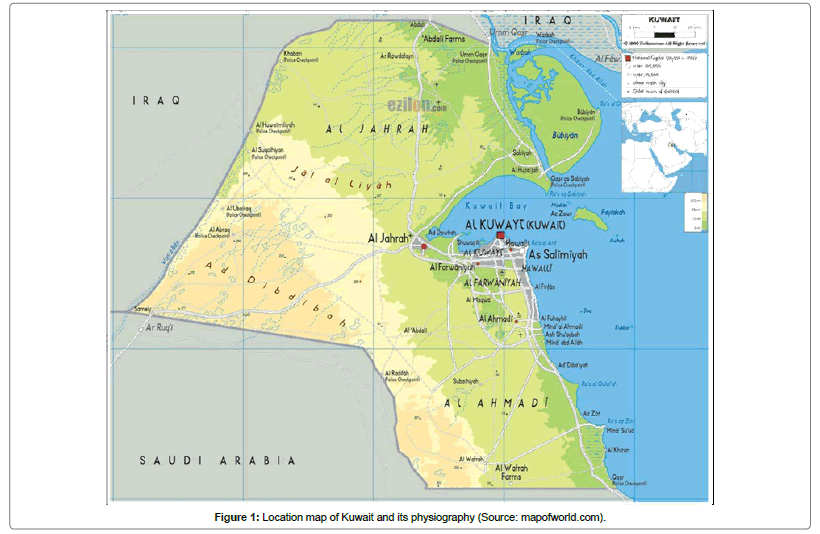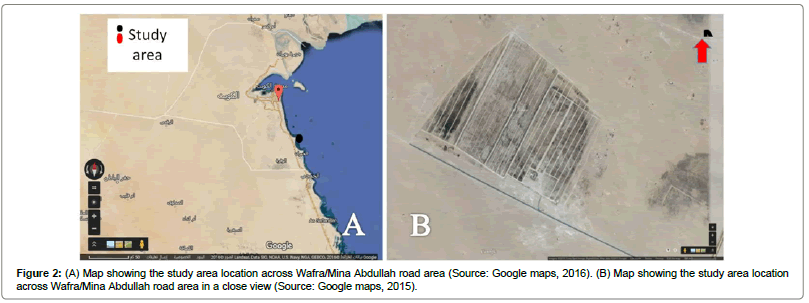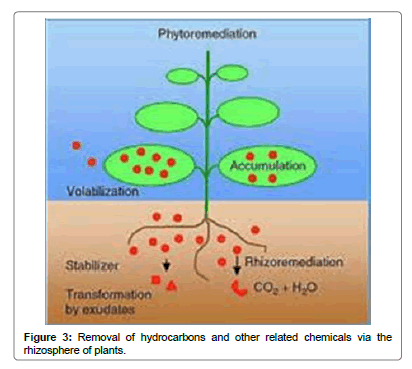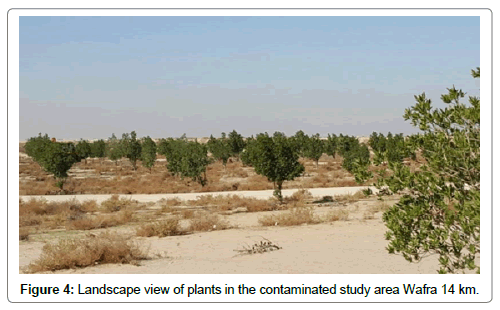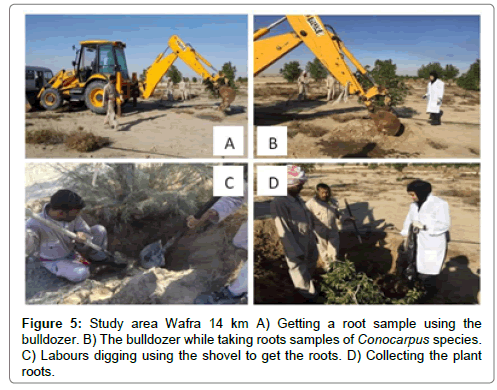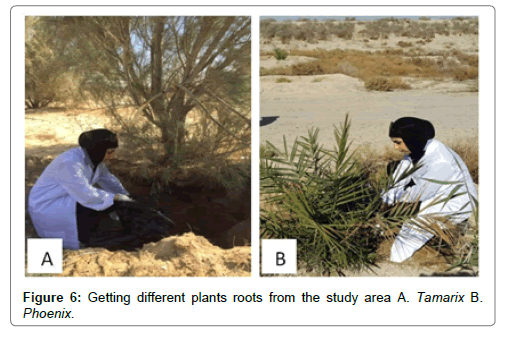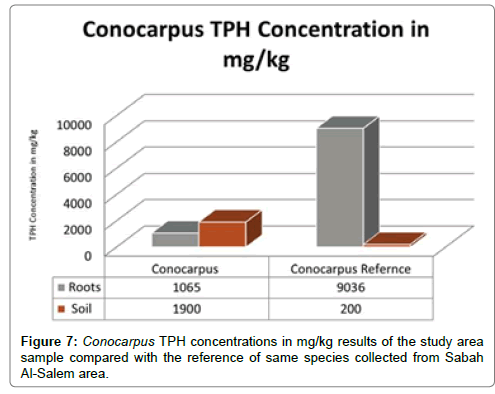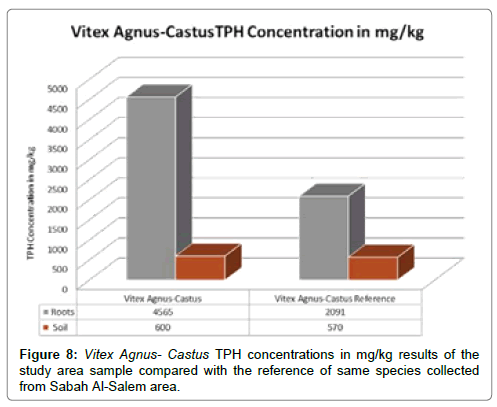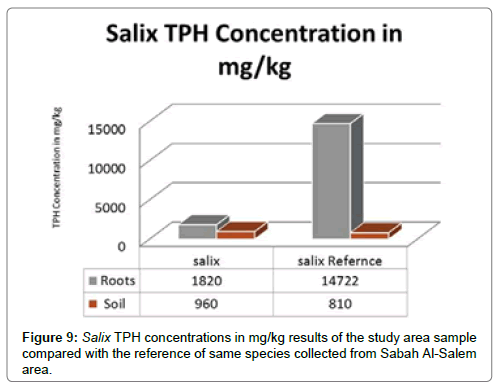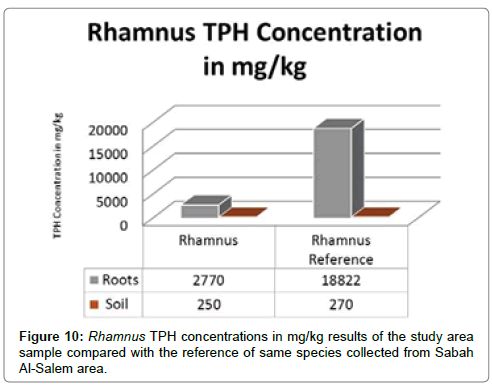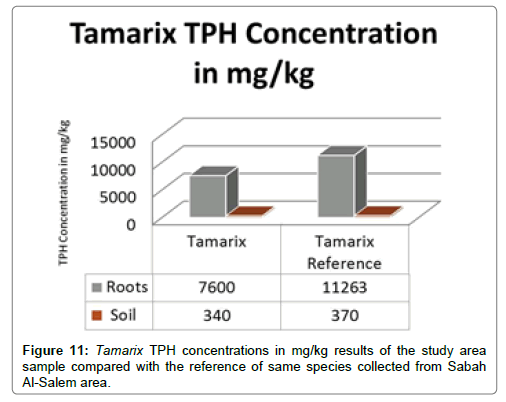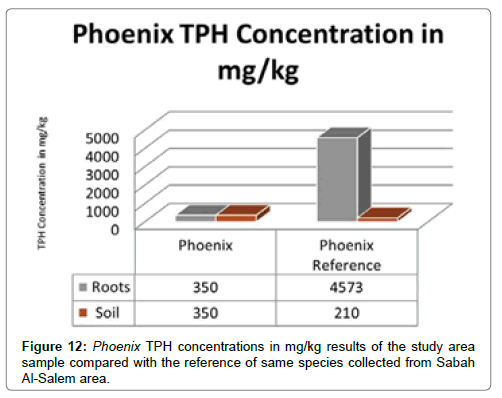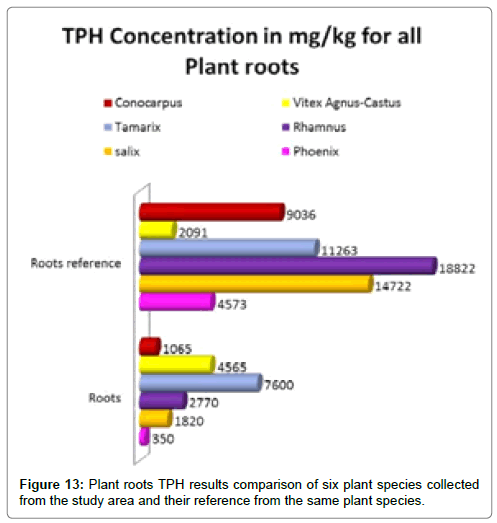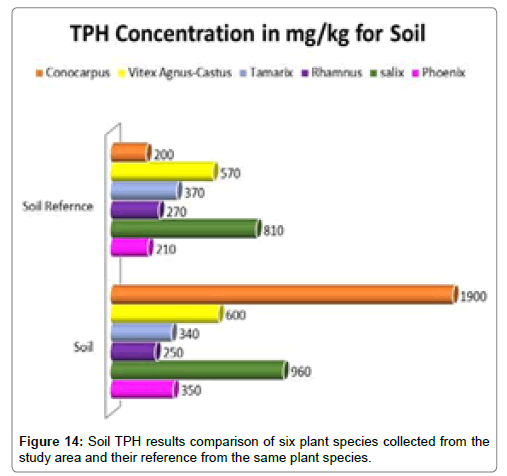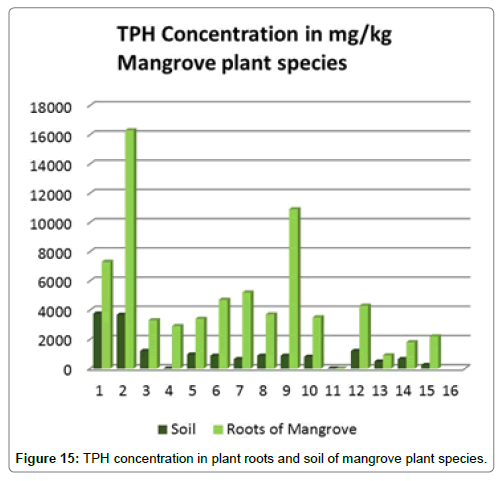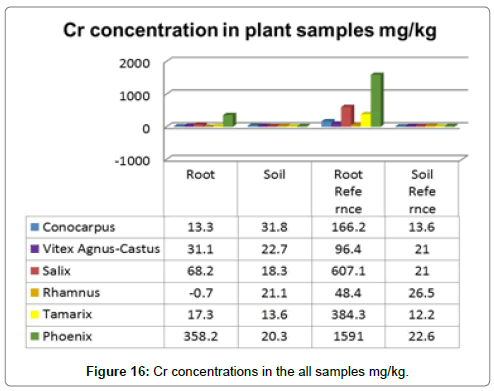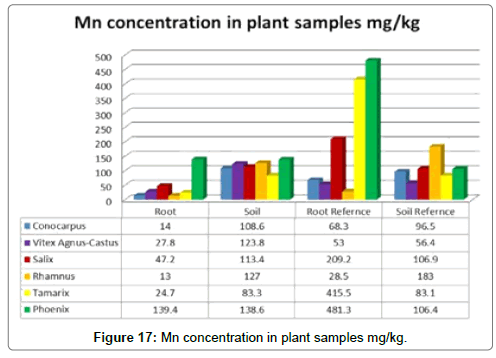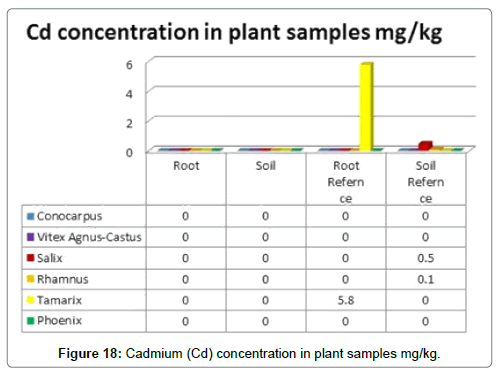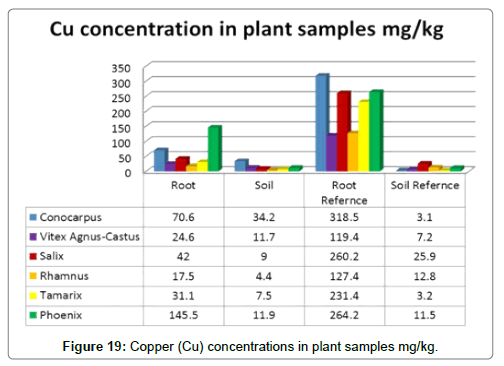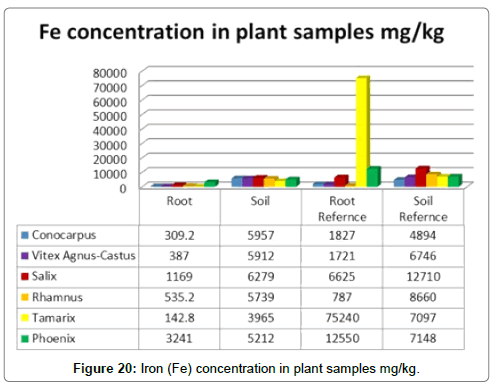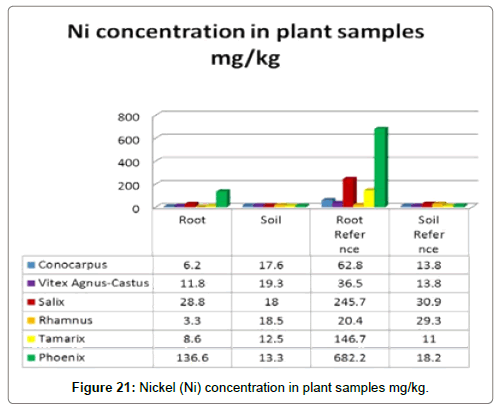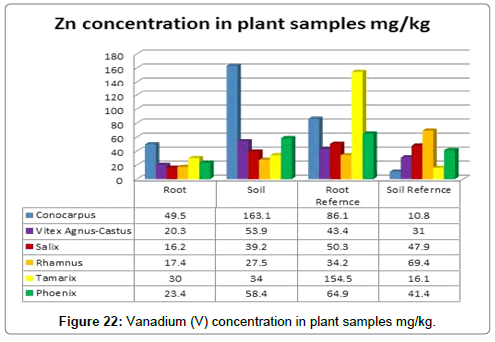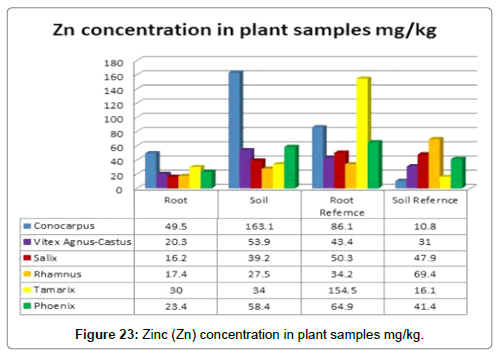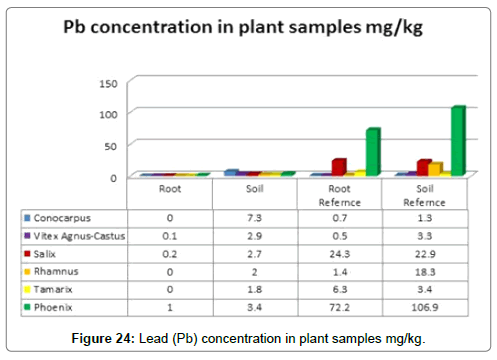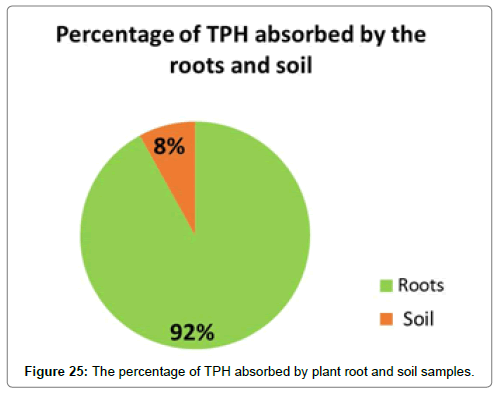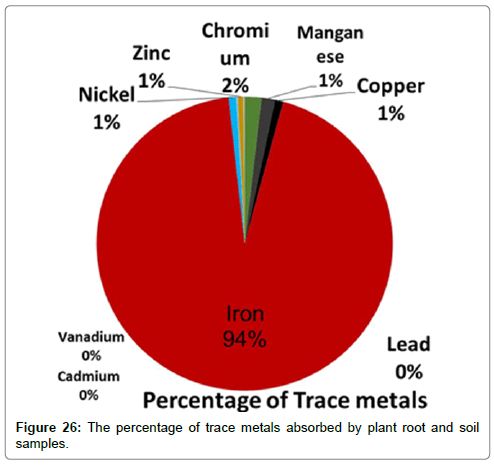Research Article Open Access
Rhizoremediation of Contaminated Soils by Comparing Six Roots Species in Al-Wafra, State of Kuwait
Danah Khazaal Al-Ameeri and Mohammad Al Sarawi*Earth and Environmental Science, College of Science, Kuwait University, Kuwait
- *Corresponding Author:
- Mohammad Al Sarawi
Earth and Environmental Science
College of Science, Kuwait University, Kuwait
Tel: 00965 99179176
Fax: 00965 24816487
E-mail: sarawi500@gmail.com
Received date: January 11, 2017; Accepted date: January 27, 2017; Published date: January 31, 2017
Citation: Al-Ameeri DK, Al Sarawi M (2017) Rhizoremediation of Contaminated Soils by Comparing Six Roots Species in Al-Wafra, State of Kuwait. J Bioremediat Biodegrad 8:384. doi:10.4172/2155-6199.1000384
Copyright: © 2017 Al-Ameeri DK, et al. This is an open-a ccess article distributed under the terms of the Creative Commons Attribution License, which permits unrestricted use, distribution, and reproduction in any medium, provided the original author and source are credited.
Visit for more related articles at Journal of Bioremediation & Biodegradation
Abstract
Toxic heavy metals concentrations in soils are locally quite high in Kuwait due to the gulf war in 1991. There are many reasons that make heavy metals high in Kuwait soils such as massive oil spills and direct dumping of untreated sewage and hydrocarbons. Phytoremediation may offer a possible solution to this problem because it might treat the soils through the use of plants even without the demand of removing the contaminated material and disposing it elsewhere. This research project will discuss the best contribution among six types of plant (tree) species (Conocarpus, Tamarix, Phoenix, Rhamnus, Vitex Agnus-Castus and Salix) collected from Wafra 14 km south Kuwait and another six reference trees from the same plant species collected for correlation from Sabah Al -Salem residential area. The samples are divided into two sample categories (roots and soil). From the chemical analysis it was found that rhizoremediation is a unique process in decreasing the level of soil contamination of hydrocarbons and trace metals. The most effective part of the plant in accumulating hydrocarbons and heavy metals were the roots while the appropriate plant was Tamarix. As a recommendation there is a need for studying the fruits of Phoenix to detect accumulates of TPH and Trace Metals and to decrease the harmful effects of the fruits on the human.
Keywords
Bioremediation; Pollutant; Rhizoremediation; Hydrocarbons; Trace metals
Introduction
The study area is located in south of Kuwait along Wafra/Mina Abdullah road at 14 km (Figure 1). The area is about 1 km2 and it receives over than 4500 m3 daily of industrial hazardous liquid waste and untreated sewage in one of the largest unlined evaporation ponds in the State of Kuwait. The study area now is completely rehabilitated and planted by several types of plants in four main sectors comprises 45000 trees. This research project will focus on the most efficient and beneficial plant out of six plants that were planted in Wafra/ Mina Abdullah 14 km, to treat the contaminated soils in many areas of Kuwait. Thus, reducing and/or eliminating contaminants and restoring or partly restore the ecological service function of soil. The State of Kuwait is in Western Asia located at the north eastern corner of the Arabian Gulf on the Arabian Plate. It has a strategic location at the head of the Arabian Gulf and shares borders with Iraq and Saudi Arabia. Kuwait’s area is about 17,818 km2 and it lies between latitudes 28°30’ and 30°05’ N, and longitude 47°30’ and 48°36’ E.
The main objectives of this study:
• To understand the behavior of the six tree plants roots in absorbing pollutants.
• To study the rate of fate and flux of pollutants.
• To evaluate the roots and soils of the different six plants in cleaning the contaminated soil.
• To make a recommendation for the best out of six tree plants selected in the study area in absorbing hydrocarbons and trace metals from contaminated soil.
This will be achieved through:
• Determining the level of total petroleum hydrocarbon (TPH) in plant’s (roots and soil).
• Measuring Trace Metals accumulation (TM) in plant’s (roots and soil).
• Chemical comparisons between the plants and soil samples.
This research will focus on studying the plant roots specially and identifying the most efficient tree out of the six trees that were planted in the study area in absorbing contaminants (Figure 2).
Literature Review
Refractory organic harmful and toxic chemicals have accumulated for decades as a result of industrial activities and caused soil contamination. Soil contamination is the essential source that transmits toxins like heavy metals from environment to living beings. Plants adsorb heavy metals from soil. Heavy metals enter the animal’s kingdom including people through the food chain, and cause a lot of health risks [1].
Many published research have been proved that plants play an important role in removing heavy metals from contaminated soils. Plants and Microorganisms are possessed by many mechanisms to avoid heavy metal poisoning. Metal efflux particularly which is represented in eubacteria is a famous example in addition to synthesis of metal-binding peptides like metallothionein (MTs). Also, it is representing in plants, fungi, blue-green algae and phytochelatins [2,3]. Additionally, Plant roots cause changes at the soil-root interface as they discharge inorganic and organic mixes (root exudates) in the rhizosphere. The number and activity of the microorganisms, the accumulation and stability of the soil particles around the root, and the availability of the contaminants are affected by the root exudates. The availability of the contaminants in the root zone (rhizosphere) of the plant can be increased or decreased directly or indirectly by root exudates themselves through changes in soil characteristics, release of organic substances, changes in chemical composition, and/or increase in plant-assisted microbial activity (International Environmental Technology Centre (IETC).
Building up vegetation spread on generally contaminated perilous waste destinations may be a proficient way and low support strategy to waste remediation. Connection between plant roots and rhizosphere microflora altogether upgrades corruption of unsafe organic compounds in polluted soil [4]. Also, metals are cycling at low rates inside and between bio, geo, atmospheric and hydrosphere frameworks. However, still metals that are collected in soils are dependable to higher dangers since they are drained into ground and surface water. After that, uptake process assimilates and a store metal in plants and after that direct or indirect intake by human population occurs. According to Karenlampi et al. [5] metals are dangerous in the event that they are available at expanded levels of bioavailability for example essential (Mn, Zn, Cu, Mo, Fe, Ni) and non-essential metals (Pb, Cd, Cr, Hg). Metal hyper aggregating discovery properties in certain plants expressed that it might be conceivable to utilize these plants for the cleanup of heavy metal pollution in soil and water. This way to deal with environmental restoration has been termed phytoremediation [6,7].
The use of plants in bioremediation of soils has been proposed as an attractive technique and because of expanded metal fixations on most living creatures, numerous strategies were produced to remediate or phytoremediate contaminated soils. However, plants do not have the uncommon biodegradative abilities that microorganisms have, so another innovation, called rhizoremediation has emerged. The available methods are costly, environmentally invasive, and labor intensive. However, remediation technique is low. The utilization of green plants to expel, i.e., phytoremediation contains or diminishes innocuous contaminants from environment.
Plants cover can be an effective technique to prevent contaminants spread by reducing erosion process done by wind and surface run off. Furthermore, it is reducing percolation to the ground water. Plants may also be used to remove contaminants from soil by phytoextraction and then harvested for processing [8-11]. There are some promising results suggesting that these techniques might become practical alternatives to mechanical and chemical approaches in remediation of metal contaminated soils [5]. Recently, rhizoremediation objective is to upgrade and develop innovative, economical, and environmentally compatible approaches to remove heavy metals from the environment. Thus, phytoremediation targets currently include contaminating metals, metalloids, petroleum hydrocarbons, pesticides, explosives, chlorinated solvents, and industrial byproducts as stated by Cunningham et al. [8]. The biological technologies that can be employed in the remediation of contaminated soils are Bioremediation, phytoremediation and rhizoremediation. This study will focus on rhizoremediation.
Rhizoremediation
Rhizoremediation is a process where microorganisms degrade soil contaminants in the rhizosphere (Figure 3). It is use plant roots and associated microbial consortium to degrade environmental pollutants from soil with an aim of restoring area sites to a condition useable for intended purpose. Rhizoremediation takes advantage of plant roots natural symbiosis with a fungus which grows in association with the roots of a plant called mycorrhiza and root associated natural microbial flora for the enhanced degradation of pollutants in the rhizosphere [12]. This method can remediate the soil pollutants which are generally organic compounds that cannot enter the plant because of their high hydrophobicity. Generally, plants are not considered as the main mode of remediation in this procedure. Rather, the plant creates a niche for rhizosphere microorganisms to do the degradation. Rhizosphere microorganisms are served by the plant acting as a solar-powered pump that draws in water and the pollutant while producing substrates that benefit microbial survival and development. Root exudates and root turn over can serve as substrates for microorganisms that perform toxin degradation.
Determination of organisms has been attempted with great achievement to be useful in rhizoremediation. Utilizing pollutant soil as an initial media to select from, enrichment of bacteria that can survive on the contaminant. This enrichment can then be inoculated onto plants where selection for root colonization can be done. Utilizing this process will result in a host plant that backings a toxin degrader in its rhizosphere. Wild type organisms are selected this procedure and accordingly there is no constraint for usage as with genetically modified microorganisms [13] depicts the successful use of this technique to identify the rhizosphere PAHs degraders (Table 1). Rhizoremediation is usually less costly than competing alternatives such as soil excavation, pump-and-treat, soil washing, or enhanced extraction.
| Plant | Pollutant | Microbes |
|---|---|---|
| Rice (cv.Supriya) | Parathion | Not identified |
| Mixture of grass, legume, herb and pine | TCE | Not identified |
| Prairie grasses | PAHs | Not identified |
| Prairie grasses | PAHs | Not identified |
| Grasses and alfalfa | Pyrene,anthracene,phenanthrene | Not identified |
| Sugar beet (cv.Rex) | PCBs | Pseudomonas fluorescens |
| Unidentified wild plant(compositae) and Senecusglaucus | oil | Arthobacter/Penicillium |
| Barley(Hordeumvulgare) | 2,4-D | Bukholderiacepacia |
| Alfalfa and alpine bluegrass | Hexadecane and PAHs | Not identified |
| Wheat (Triticumaestivum) | 2,4-D | Pseudomonas putida strains |
| Poplar (Populusdeltoidesnigra) | 1,4-dioxane | Actinomycetes |
| Wheat | TCE | P. fluorescens |
| Oat,lupin,rape,dill,pepper,radish,pine | Pyrene | Not identified |
| Reed (Phragmitisaustralies) | Fixed nitrogen | Nitrospira sp. And Nitrosomas sp. |
| Poplar root extract | 1,4-dioxane | ActinomyceteAmycolata sp. CB 1190 |
| Corn (Zea mays) | 3-methylbenzoate | P. putida |
| Astragalussinicus | Cd+ | Mesorhizobiumhuakuii |
| Fern (Azollapinnata) | Diesel fuel | Not identified |
Table 1: Rhizoremediation of various environmental pollutants [15].
Role of plants in rhizoremediation: Certain plants are better at removing contaminants than others. There are many factors must be able in the plants used for phytoremediation. They must be able to tolerate the concentrations of contaminants present. Also, they must be able to grow and survive in the local climate. Another factor is important such as the depth of contamination. If the contamination is shallow, small plants like ferns and grasses will be used. Trees such as poplars and willows are used to clean up deeper soil contamination and contaminated groundwater because tree roots grow deeper [14].
Plants may contribute to remediation in several ways, by reducing the leaching of contaminants, aerating soil, phytodegradation, phytovolatilization, evapotranspiration, and rhizoremediation. Nutrients in the rhizosphere are given by the mucigel emitted by root cells, lost root cap cells, the starvation of root cells, or the decay of complete roots [15,16]. In addition, plants discharge a variety of photosynthesis derived organic compounds [10,17]. Root exudates contain water soluble, insoluble, and volatile compounds including sugar, proteins, alcohols, amino acids, organic acids, nucleotides, flavonones, phenolic compounds and certain enzymes. Prevailing conditions that support the application of both microbes and plants depend on the selection of bioremediation or phytoremediation for cleanup of the contaminated site.
Factors affecting rhizoremediation: The different physical, chemical and biological properties of the root related to soil are soil condition, temperature, pH, organic matter, weather condition. Schroll et al. [18], Alberty [19], Guillot et al. [20], Mastronicolis et al. [21], Singh et al. [22] are responsible for changes in microbial diversity and for expanded numbers and metabolic activities of microorganisms in the rhizosphere microenvironment, this phenomenon called the rhizosphere effect [10,15,17,23]. Many studies have investigated the effects of soil moisture, temperature, aeration, pH, and organic matter content on the biodegradation of pesticides [11,24]. The age of a plant, the availability of mineral nutrients and the presence of contaminants are responsible of the rate of exudation changes [25]. The nature and the quantity of root exudates, and the timing of exudation are crucial for a rhizoremediation process. Plants might respond to chemical stress in the soil by changing the composition of root exudates controlling, in turn, the metabolic activities of rhizosphere microorganisms [25]. The root exudates mediate acquisition of minerals by plants and stimulate microbial growth and activities in the rhizosphere in addition to changing some physicochemical conditions. Some organic compounds in root exudates may serve as carbon and nitrogen sources for the growth and long-term survival of microorganisms that are capable of degrading organic pollutants [10,17,26].
Improvement in rhizoremediation: Rhizoremediation procedure can be intended to enhance in several perspectives like bioavailability of contaminant molecules, expression and support of genetically engineered plant microbial frameworks and root exudates for the effectiveness of the procedure. An interesting alternative to improve the removal efficiency is selection of bacteria. Bacteria are produce biosurfactants in the plants rhizosphere. Kuiper et al. [15] applied bioremediation and distinguished bacteria developing in contaminated area that produces biosurfactants that encourage the solubilisation of PAHs and thus biodegradation by microbes. This property is additionally of interest because various biodegradative microorganisms show positive chemotaxis towards the contaminations. Thus, the consolidated activity of biosurfactant and chemotaxis can add to bacterial expansion and to microbial spread in contaminated soils, all together that more abundant zones can be cleaned. Microbial degradation of pollutants in the rhizosphere gives a constructive outcome to the plant; the toxin concentration is diminished in the zone close to the roots and the plant can develop better to those in contaminated zones. Because of this shared advantage it has been recommended that plants can choose particular genotypes to be available in their roots. Many experiments performed by Siciliano et al. [27] exhibited that the presence of the alkane monooxygenase quality was more pervasive in endophytic and rhizosphere microbial groups than in those present in bulk soil contaminated with hydrocarbons. This recommends if plants are impacting the rhizosphere, this impact is subject to the contaminant. Additionally, a few researchers concluded that the impact depended on the sort of the plant. This has led to the hypothesis that the viability of rhizoremediation methodologies is identified with the determination of the best plant bacterium pair in each case.
An environmental evaluation for the industrial and sewage wastes in Kuwait [28]
This study examined Al- Wafra 14 km since it is the main area that gets the industrial waste and the fluid from all other areas. The main point of this study was to evaluate and contribute groundwater, soil and air which are the probable contaminants that came from human activities to enhance the environment and people’s health and helping the authorized people to plan for the future of country and environment actions by taking the fitting activities for ensuring these resources.
TPH analysis: TPH results showed high percentages in Wafra 14 km (Table 2). The acceptable TPH amount on earth should be 10 mg/l according to the International Bank while in Wafra the mean values of TPH showed 97.46 mg/l as shown in Table 3. Besides, natural Kuwaiti laws express the need to treat the consumed oils that contains high measure of hydrocarbons substances because of its hurtful impact on environment. Subsequently, they accepted a rate of 5 mg/l TPH.
| ID | V | Cr | Fe | Ni | Cu | Zn | Cd | Pb | TPH |
|---|---|---|---|---|---|---|---|---|---|
| Unit | (mg/L) | (mg/L) | (mg/L) | (mg/L) | (mg/L) | (mg/L) | (mg/L) | (mg/L) | (mg/L) |
| Mean | 1.16 | 0.31 | 71.29 | 2.83 | 0.39 | 7.69 | 0.5 | 0.4 | 97.4 |
| Minimum | 0.07 | 0.15 | 19.9 | 0.49 | 0.11 | 3.98 | 0.0069 | 0.18 | 1.69 |
| Maximum | 6.55 | 0.81 | 282.9 | 9.95 | 1.10 | 17.72 | 3.1 | 1.07 | 523 |
| Std.Dev. | 1.76 | 0.19 | 78.2 | 2.7 | 0.26 | 4.41 | 1.04 | 0.26 | 164.5 |
| 1-KEPA standards | - | 0.15 | 5 | 0.2 | 0.2 | 2.0 | 0.01 | 0.5 | 5 |
| 2-KEPA Standards | 0.1 | 0.15 | 5 | 0.2 | 0.2 | 2.0 | 0.01 | 0.5 | 10 |
Table 2: Statistics analysis of trace metals (TM) and total petroleum hydrocarbons (TPH)samples conducted in Wafra 14 km [28].
Trace metals analysis (TM): Heavy metals such as Cd, Cr, Cu, Ni, Pb, and Zn in soils cause noteworthy dangers to human, animals as well as to environment. Human activities have expanded as an aftereffect of the Industrial Revolution and were the main causes of heavy metal deposition. Modern exercises, smelting, electroplating and Agriculture have brought about the deposition of undesirable concentrations of metals in soil. Addition of Trace metals might be hurtful to Humans, animals, plants and different life forms such as organisms reaching the soil or groundwater. In Table 3, the results of trace metals concentrations in Wafra 14 km showed that all of the values are above the acceptable local limits.
| ID | V | Cr | Fe | Ni | Cu | Zn | Cd | Pb | TPH |
|---|---|---|---|---|---|---|---|---|---|
| Unit | (mg/L) | (mg/L) | (mg/L) | (mg/L) | (mg/L) | (mg/L) | (mg/L) | (mg/L) | (mg/L) |
| IA | 0.5707 | 0.2476 | 37.9017 | 0.8922 | 0.4025 | 5.5232 | 0.0186 | 0.6762 | 54.3 |
| 1B | 0.9354 | 0.4209 | 282.9234 | 6.2901 | 0.3624 | 15.7374 | 2.2618 | 0.6585 | 17.9 |
| 1C | 6.5557 | 0.8118 | 176.6287 | 2.5396 | 1.1045 | 17.7218 | 0.0231 | 1.0749 | 9.73 |
| 2A | 0.9241 | 0.5019 | 27.0217 | 0.4911 | 0.6518 | 4.1066 | 0.0156 | 0.2224 | 10.1 |
| 2B | 0.0748 | 0.2803 | 45.081 | 2.7268 | 0.3044 | 7.7437 | 0.0747 | 0.3535 | 18.5 |
| 2C | 0.5753 | 0.3197 | 34.2768 | 9.9575 | 0.1704 | 4.9234 | 0.0069 | 0.2792 | 14 |
| 3A | 0.1764 | 0.1555 | 58.0832 | 1.8628 | 0.3318 | 6.374 | 3.1094 | 0.2613 | 206 |
| 3B | 0.1015 | 0.1598 | 40.3729 | 1.8628 | 0.3318 | 7.9874 | 0.0242 | 0.3132 | 523 |
| 3C | 0.7205 | 0.2089 | 58.9177 | 3.2001 | 0.1138 | 5.3476 | 0.4703 | 0.208 | 303 |
| 4A | 1.0831 | 0.1916 | 29.3609 | 1.9591 | 0.338 | 6.4256 | 0.0114 | 0.2648 | 1.69 |
| 4B | 0.4262 | 0.1587 | 19.9392 | 0.9415 | 0.3265 | 3.9842 | 0.0207 | 0.182 | 2.4 |
| 4C | 1.8826 | 0.2657 | 45.05 | 1.8394 | 0.4364 | 6.5064 | 0.0079 | 0.3202 | 9 |
Table 3: Trace metals analysis results of Wafra 14 km [28].
Phytoremediation for hazardous liquid industrial waste Al-Wafra [29]: In 2012 unpublished thesis study done by Alia Bado had done at the same study area Al-Wafra. The chemical analyses were done systematically at the laboratory following the Vista-MPX CCD Simultaneous ICP-OES for five plant samples collected (Salix Fragilis, Albizzia, OleaEuropaea, Ziziphus and Tamarix). Table 4 showed the trace metals which were analyzed for the five plant species. The study concluded that the high concentration of trace metals absorbed by the Tamarix plant and is the most satisfactory plant that could be utilized in Kuwait for phytoremediation process [29].
| Sample ID | Cr | Mn | Cd | Cu | Fe | Ni | V | Zn | Pb |
|---|---|---|---|---|---|---|---|---|---|
| Tamarix | 6.607 | 52.77 | 0.204 | 41.201 | 181.146 | 4.432 | BDL | 94.05 | BDL |
| Albizzia | 3.945 | 49.486 | BDL | 24.234 | 201.538 | 0.957 | BDL | 28.027 | BDL |
| Salix Fragilis | 2.396 | 40.095 | BDL | 15.187 | 78.617 | 2.152 | BDL | 26.623 | BDL |
| Ziziphus | 1.682 | 67.103 | BDL | 9.192 | 69.121 | 0.213 | BDL | 33.776 | BDL |
All values are given in ppm (mg/g)
BDL: Below detection limit. In the method used for the analysis the minimum detection level of Cd is 0.205 ppm. V is 0.800 and Pb is 1.400 ppm.
Table 4: L-methionine production by Corynebacterium glutamicum X300 using significant nutritional parameters based on CCD.
Phytoremediation for hazardous liquid industrial waste using six famous trees species in Al Wafra [30]: Another unpublished thesis study done by Mohammed Al-Ibrahim in 2015 conducted in the same contaminated study area Wafra 14 km. He collected six types of plant tree species (Conocarpus, Tamarix, Phoenix, Rhamnus, Vitex Agnus-Castus and Salix) and studied different plant part (leaves and stem) from the contaminated area. The study showed that the best part absorbed and stored the contaminants and the Trace Metals is the leaves. Vitex Agnus-Castus species leaves got the highest storage of TPH amount. Stems samples TPH analysis revealed that the highest TPH storage is of Rhamnus and the least one is Tamarix. However, TPH analysis of soil samples collected from the study area showed that the least plant could absorb the contaminants from soil got the highest value of TPH, which is Conocarpus species.
The study concluded that Vitex Agnus-Castus species is the most adequate plant that could be used for phytoremediation process in Kuwait according to the high concentration of the TPH and trace metals absorbed by the plant leaves [30].
Regional case study of phytoremediation
Does phytoremediation work at every site? [31]: A study has been carried out examining the growth characteristics and performance of mangroves, halophytes and other plants in soil irrigated with saline water in the United Arab Emirates. Salinity is a serious threat for crop production in arid regions, where the high rate of evaporation, combined with the demand for scarce water reserves, causes salt build-up during the cultivation process. The study showed that some plants have the necessary physiological mechanisms and capacities to accumulate significant concentrations of iron, manganese and magnesium, calcium, sodium and chloride ions, thereby reducing the overall salinity of the soil system and potential related effects on crop physiological and growth performance. Based on this work, it has been suggested that by introducing highly salt-tolerant species (i.e., Conocarpus erectus, Atriplex lentiformis, etc.) that can be irrigated with saline water, higher plant and agricultural production levels in arid regions can be achieved.
International case study of phytoremediation
Petroleum hydrocarbons pollution in soil and its bioaccumulation in mangrove species, Avicennia marina from Alibaug mangrove ecosystem, Maharashtra, India [32]: A study done by Lotfinasabasl [32] had investigated the capability of mangrove species, Avicennia marina for bioaccumulation of petroleum hydrocarbons from contaminated soil. The results showed that the TPH concentration was vary in leaves, roots and seedlings at the same plant and it was showing higher uptake of petroleum hydrocarbons by roots took after by seedlings and leaves.
The study concluded that Avicennia marina is observed to be a potential species for protection of coastal ecosystem. Phytoremediation has been recognized as a practical, naturally benevolent, stylishly satisfying procedure for evacuation of ecological toxins [32].
Materials and Methods
From the study area Wafra 14 km as shown below (Figure 4), six types of plant tree species were collected (Conocarpus, Tamarix, Phoenix, Salix, Rhamnus, and Vitex Agnus-Castus). Another six reference trees were collected for correlation from Sabah Al -Salem residential area from the same plant species. The samples were divided into two sample categories (plant roots and soil) of each plant in the study. Therefore, the total numbers of samples collected are 24 samples including mixed treated soil (Figures 5 and 6). Total Petroleum Hydrocarbons (TPH) and Trace Metals analysis will be performed for duration of four months, starting from (November 2015 – March 2016). The samples collected and analyzed for determining the concentration of total petroleum hydrocarbon (TPH) and trace metals (TM).
Getting the plant roots samples from the study area was difficult so a bulldozer was used to extract the roots (Figures 5A and 5B) then the plant was replanted again at the same time. Several labors were helping to continue the root extraction by using shovels (Figure 5C). Finally, the root samples were collected very carefully in a plastic bag (Figure 5D).
Field work
The fieldwork conducted on the contaminated soil in the Wafra/ Mina Abdulla road 14 km. The study area includes 12 samples which were divided as 6 samples of plant roots and 6 soil samples. In addition, 12 reference samples were collected from Sabah Al-Salem residential area, another six plants roots samples from the same species and 6 soil samples.
Results and Discussion
The utilization of plants for remediation might be particularly appropriate for soils polluted by organic chemicals to profundities of less than 2 m. Accordingly, the collaboration between plant roots and rhizosphere microflora fundamentally improves degradation of dangerous natural mixes in polluted soil. The root arrangement of plants can spread microbes through soil and infiltrate generally impermeable soil layers. The immunization of contamination degrading microscopic organisms on plant seed can be an essential added substance to enhance the proficiency of phytoremediation [15]. Through degradation or gathering plants can cooperate with dangerous natural mixes. Uptake of poisons in plants roots is an immediate capacity of the contaminant amount and concentration in the solution of soil and large contains compound isolating connected to the root surfaces took after by development over the cortex to vascular arrangement of plants [33]. The contamination may be bound or processed at whatever time among transference. Toxins in plants might be found as uninhibitedly extractable stores, extractable conjugate bound to plant material, and unextractable developments combined in plant tissue.
Plants may by implication add to the dispersal of contaminants in vegetated soil. The usage of plants to concentrate toxic mixes from soils (phytoextraction) is being made as a framework for remediation of metal sullied soils [11,34,35]. Phytoremediation is a suitable remediation technique for petroleum contaminated soil based on evidence from greenhouse and field studies. The utilization of vegetation for remediation of polluted sites is attractive because it is cheap and passive. Plants can gather trace metals, in or on their issues as a result of their capacity to adjust to variable chemical properties of the environment: in this way, plants supplies through which trace elements from soils, waters and air, move to man and animals [36]. According to Srinivas et al. [37] air and soil are the main sources of trace metals to plants from which the root foliage take up the trace metals. Generally, metals are concentrated in the root and absorbed by plant through root uptake
Total petroleum hydrocarbons analysis
TPH is well -defined as the quantifiable amount of petroleum -based hydrocarbon in an ecological media. It is, thus, reliant on analysis of the medium in which it is found. This section explains the TPH analysis results that were conducted in the study area on different six plants species compared to similar ones from different areas as references samples. In this section we would explain the total petroleum hydrocarbons analysis of the six plants samples collected from the study area in Wafra 14 km (Conocarpus, Vitex Agnus-Castus, Salix, Rhamnus, Tamarix and Phoenix).
Conocarpus: Conocarpus or Button mangrove is a widespread species of terrestrial mangrove. On the coastal mainland, it grows as a small tree and has a variety of sizes on islands. Conocarpus has downy smooth leaves. It tolerates many things such as lowly drainage, compressed soil, air contamination and drought so that it is exceptionally adjustable as a decorative [38,39]. From total petroleum hydrocarbons analysis (TPH) of Conocarpus samples collected from the contaminated study area the soil had high rate of TPH value than the roots. On the other hand, the reference from same species collected from Sabah Al-Salem residential area depicted that the roots possessed the highest TPH value compared to soil which is about 9036 mg/kg as shown in Figure 7. The reference sample showed higher amount of TPH and that could be due to the age of plant and/or its nearness of a sewage area.
Vitex Agnus-Castus: Vitex Agnus-Castus is one of the common flowering plants and has many uses such as medical and herbal uses. It varies in size from small to tall tree. Vitex Agnus-Castus leaves are shaped liked a hand or palmate, and were once accepted to have sedative impacts. If Vitex Agnus-Castus soil kept too moist it would decline due to the root rot [38]. The results of Total Petroleum Hydrocarbons (TPH) of study area and reference samples collected from Sabah Al- Salem residential area showed that Vitex Agnus-Castus roots stored the highest amount of TPH 4565-2091 mg/kg compared to soil 600-570 mg/kg (Figure 8).
Salix: Around 400 species of deciduous trees and shrubs form the genus Salix were found in many regions [40]. Salix leaves are typically elongated and sometime may be round to oval. The roots grow from aerial parts of the plant and they are remarkable for their toughness and size. Salix as a plant have many environmental uses. It is used for biofiltration, wastewater treatment systems, phytoremediation, windbreak and soil building. From the roots TPH results, the value ranges from 1820-1477 mg/kg whereas soil TPH ranges from 960-810 mg/kg (Figure 9). As mentioned before, the reference sample showed higher amount of TPH and that might be due to the age of plant and/or its nearness of a sewage area.
Rhamnus: Rhamnus species are varying in size from shrubs to medium sized trees. The Rhamnus leaves are undivided and innately veined. The collected sample of Rhamnus roots from study area and the reference area are highly stored the contaminants 2770-18822 mg/ kg and the low amount of contaminants stored in soil 250-270 mg/kg (Figure 10).
Tamarix: Tamarix is one of flowering plants that composed of many species. It grows as tree in the arid area. Tamarix can tolerate a lot of environmental conditions. It is capable to exploit a wide spectrum of habitats because of the genotype in saltcedar [41]. Moreover, Tamarix TPH analysis reveals that the roots stored efficiently the soil contaminants in the study area and reference area at Sabah Al-Salem. Total Petroleum Hydrocarbons (TPH) values of Tamarix roots were the highest 7600-11263 mg/kg whereas the soil comprises 340-370 mg/kg. Soil sample collected from the contaminated study area is little lower than the TPH amount the one collected as a reference from the similar species in Sabah Al- Salem area (Figure 11).
Phoenix: Phoenix is a genus of palms family. Phoenix is widespread and commonly grown palm in the world. They are growing in many varied climates such as tropics, arid and even in cold climate. The TPH results of Phoenix samples collected from the study area showed that the plant’s root and soil were storing the same amount of Total Petroleum Hydrocarbons (TPH) 350 mg/kg (Figure 12). However, the Phoenix reference sample collected from Sabah Al-Salem area were having higher amount of TPH 4573-210 mg/kg compared to the sample collected from Al-Wafra 14Km and that might be due to age of plant and/or its nearness of a sewage area.
Total petroleum hydrocarbons (TPH) results comparison between plant’s root and soil
Plant’s root: TPH concentration results of the six plants species collected from the study area and their reference samples of the same species collected from Sabah Al-Salem area will be compared in this section. This comparison will show TPH concentration results for plant’s root of all the plants species and the higher TPH value will be determined. TPH results of plant roots showed that the highest value goes for Tamarix 7600-11236 mg/kg in both reference and study area samples (Figures 13).
Soil: Soil TPH concentration results depicted that the introduced planted Conocarpus soil was having the highest amount of contaminants in the study area 1900 mg/kg (Figure 14).
Comparisons between TPH results in plant roots and soil from this study and TPH results in plant roots and soil from another study [32]
A study by Lotfinasabasl [32] for different plant species roots (mangrove) find out that the highest amount of TPH was 16300 and the TPH amount in the soil was 3760, while from this study the highest amount of TPH in plant root collected from the study area Al-Wafra 14 km was 7600 mg/kg and TPH amount in the soil was 1900 (Figure 15).
Trace metals analysis in plants and soil
In geochemistry, the term “trace metals” has been used for the chemical elements that occur in the Earth’s crust. The amount of the trace metals in the Earth’s crust is less than 0.1% which is about 1000 mg/kg [36]. Nowadays, the term “heavy metals” are used widely and that because of chemical hazards [42]. Plants are capable of absorbing a quantity of elements from soil, some are known to be lethal at low concentrations and some have no recognized biological purpose. Plants can accumulate high concentrations of heavy metals in their tissue. Serious danger to individual human health can result from the plants which are growing in a contaminate environment and collect trace elements at high concentrations. Roots depend on speciation of metal and soil types and kind of plant species to uptake of metal concentration root [37].
This section will explain the chemical analysis for the six plants root samples and soils were collected from the study area and the references area (Conocarpus, Vitex Agnus-Castus, Salix, Rhamnus, Tamarix and Phoenix).
Chromium (Cr): Chromium (Cr) is the 22nd most abundant element in Earth's crust. It has an average concentration of 100 ppm [6,7]. Chromium is a remarkable metal for being profoundly impervious to oxidation even at high temperatures. It has a high melting point. Chromium is discharged into the environment by industries. It affects the soil fertility and the microbial activity of the soil. The high concentration of Chromium in the soil may cause the losses of plants. The permissible limit concentration for Cr in plants is 1.5 ppm (mg/g) [43]. Chromium (Cr) concentrations in study area plant’s root samples are ranging from -0.7- 358.2 mg/kg and soil samples 13.6-31.8 mg/kg. The highest level of Cr recorded storage in roots goes for Phoenix 358.2 mg/kg whereas the lowest is Rhamnus at -0.7 mg/kg. The highest Cr recorded in the soil of the study area samples is Conocarpus 31.8 mg/kg and the lowest is Tamarix 13.6 mg/kg (Figure 16).
Manganese (Mn): Manganese is a naturally occurring metal that has silver color with no taste or smell. Manganese is usually found in the nature as a compound with elements such as iron, sulfur, oxygen, or chlorine [44]. It is hard and very brittle but easy to oxidize. Manganese has two forms in the environment. Inorganic manganese compounds are used in the manufacture of steel, batteries, ceramics, and nutritional supplements [44]. According to WHO [45] the Mn concentration in tend to range from 20-500 mg/kg in terrestrial plants (Figure 17).
As shown in Figure 18, Manganese (Mn) concentration in study area root samples ranges between 13-139.4 mg/kg while the reference root samples collected from Sabah Al-Salem ranges from 28.5-481.3 mg/kg. Manganese concentration of soil sample collected from study area ranges from 83.3-138.6 mg/kg whereas the reference soil sample is ranging from 56.4-106.9 mg/kg. The lowest value of Mn concentration recorded in root samples of the study area is Rhamnus 13 mg/kg and the highest level recorded is Phoenix 139.4 mg/kg. Soil samples collected from study area that showed that the lowest Mn concentration recorded is Tamarix 83.3 whereas the highest value is from Phoenix 138.6 mg/kg.
Cadmium (Cd): Cadmium is one of the naturally occurring components in the earth’s crust and waters. Many elements like: zinc, lead, and copper ores are associated with Cadmium. It is present everywhere in our environment. Cadmium is a poison and is known to cause birth defects and cancer. The pure one is a silvery metal with a bluish tinge to its surface. Cadmium chloride and cadmium sulfate are the soluble form of Cadmium in water. Cadmium is used for the following: rechargeable nickel-cadmium batteries, rods in nuclear reactors, pigments, protecting critical components of aero planes and oil platforms, stabilizers for plastics, nonferrous alloys, photovoltaic devices, and other uses.
From Figure 19, there was no concentration of Cadmium found in study area for both samples plant roots and soil whereas the highest Cd concentration found stored in reference roots samples is of Tamarix 5.8 mg/kg. However, the reference soil samples indicate that two plants species Rhamnus 0.5 mg/kg and Tamarix 0.1 mg/kg had higher Cd concentration. The World Health Organization (WHO) recommended that the maximum level of Cd in medicinal plants is 10 mg/kg.
Copper (Cu): Copper is a reddish metal that occurs naturally in rock, water, soil, sediment and at low levels in the air with concentration ranging between 8.85-13.44 mg/kg [46]. Copper is found as a pure metal in nature. Pure copper is usually too soft and ductile. Mixing copper with other metals make it strengthened. It is used as a conductor of heat and electricity, as a building material, and as a constituent of various metal alloys. Bronze and brass are the two most familiar alloys of copper. In the earth's crust the average concentration of Cu is about 50 parts copper per million parts soil (ppm) or 50 grams of copper per 1,000,000 grams of soil. Copper is found in all plants and animals. It is a crucial component for all perceived living creatures including people and different creatures at low ranks of consumption. At higher amounts, Cu can be harmful [47]. The concentration of Copper (Cu) in root plant samples of the study area was ranging from 17.5-145.5 mg/kg whereas soil samples of study area ranges from 4.4-34.2 mg/kg (Figure 20). According to Dutch Standards, the soil concentration of Cu that is below the permissible limit is 36 mg/kg. The highest level of Cu concentration in plant roots samples collected from the study area is of Phoenix 145.5 mg/kg whereas the lowest one goes to Rhamnus 17.5 mg/kg. For the soil sample taken from the study area, the highest level of Cu concentration is of Conocarpus 34.2 mg/kg whereas the lowest one goes to Tamarix 17.5 mg/kg. This present study indicate that the best plant stored Cu in Its root is Phoenix. We can notice the high percentage of Cu metal in reference area is more than the study area and that because the reference sample might be affected by its nearness from sewage pipe.
Iron (Fe): Iron is the most common element on Earth surface and is the fourth most common element in the Earth's crust. It is forming much of Earth's outer and inner core. About 4.6% of igneous rocks and 4.4% of sedimentary rocks contain iron as a regularly occurring metal [48]. Iron involves numerous biological processes. In plants, Iron plays a role in the creation of chlorophyll and is an essential part of hemoglobin in the blood. On the other hand, iron helps keep plants and animals alive. Iron classic concentrations in soils are range between 0.2%-55% [49] and that can differ in localized areas because of soil diversity and availability of other sources.
The present study finds that Iron (Fe) concentration in plant root samples collected from study area ranged between 3241-142.8 mg/kg. The lowest iron concentration is of plant root sample is of Tamarix 142.8 mg/kg and the highest one is of Phoenix 3241 mg/kg. Also, it indicates that Iron (Fe) concentration in soil samples collected from study area ranged between 6279-3965 mg/kg. The lowest Fe concentration of soil goes for Tamarix 3965 mg/kg yet; the highest one is Salix 6279 mg/kg (Figure 21). The concentration of Fe is between 20000-250000 mg/kg in dry plant tissue.
Nickel (Ni): Nickel is a shiny white transition metal. Pure nickel is hard and ductile. According to McGrath [50] nickel appears naturally in soils due to parent rock weathering. Nickel has many properties that make it extremely attractive to be alloyed with different metals like: iron, copper, chromium and zinc. These combinations are used for making metal coins and in industry. Most nickel is utilized to make stainless steel. Nickel is considered as corrosion resistant because of its slow rate of oxidation. Nickel concentration in soil is ranging from 0.7 to 259 mg/kg [45].
In our study area the Ni in roots samples is ranging from 3.3-136.6 mg/kg whereas the soil sample is ranging from 12.5-19.3 mg/kg. The root samples of Phoenix contributed the best in storing Nickel in both reference and study area as it is shown in Figure 21.
Vanadium (V): Vanadium is a rare, soft, ductile gray-white element found combined in certain minerals and is widely distributed in the earth’s crust. Vanadium occurs naturally and has many forms. Pure vanadium is a bright white, soft and ductile metal. Unintentionally discharged of coal bi-products may cause Vanadium Pollution of soil [36]. Vanadium is abundant in variable amounts in soils and it is taken up by plants at different levels. There are different ideas about the mean content of Vanadium in plants. Smith [51] mentioned that Vanadium concentration is lower than 0.5 mg/kg while others have referred concentrations ranges from 0.5-22 mg/kg. However, Cannon [52] mentioned that Vanadium concentration is from 0.8- 2.7 mg/kg.
As shown in Figure 22, the root samples analysis of the study area show that the range of Vanadium is between 0.6-12 mg/kg whereas reference samples range between 4.2-19.2 mg/kg. The least level recorded is of Vitex Angus-Castus 0.6 mg/kg in study area root samples yet; the highest one is of Conocarpus 12 mg/kg. Surprisingly, the soil samples for both study and reference area showed higher Vanadium amount [53-56]. The range of soil samples in the study area is 17.7-27 mg/kg whereas reference area samples showed a range of Vanadium concentration between 13.9-21.6 mg/kg. Moreover, the soil samples in study area had the least level in Tamarix 17.7 mg/kg whereas the highest V recorded is of Vitex Angus-Castus 27 mg/kg.
Zinc (Zn): Zinc is a bluish-white, glittery, diamagnetic metal. It is one of the most common elements in the Earth's crust. It can be found in different places such as in air, water, and soil in addition to food. Metallic zinc has many uses in industry. It is most commonly used as an anti-corrosion agent. Metallic zinc is mixed with other metals such as bronze to form alloys. It is also used to produce dry cell batteries [57,58]. Zinc sulfide and zinc oxide is usually utilized in manufacturing such as white paints, ceramics, and other products. According to Emsley 2001, soil contains 5-770 mg/kg of zinc with an average of 64 mg/kg whereas seawater has only 30 mg/kg zinc. The permissible limit of Zinc in human consumption is 10-50 [37].
This present study shows that the least zinc concentration in root samples is in Salix at 16.2 mg/kg whereas the highest one is in Conocarpus plant species at 49.5 mg/kg. The concentration of Zinc in soil samples collected from study area ranged between 27.5-163.1 mg/ kg. In another hand, the least level of Zn concentration stored in soil is of Rhamnus 27.5 mg/kg and the highest one is of Conocarpus 163.1 mg/kg (Figure 23).
Lead (Pb): Lead is a bluish to gray or bluish-gray metal that occurs naturally in the Earth's crust. It is a heavy metal with high density. Lead has the highest atomic number of any non-radioactive element. Yet, it is easily discovered naturally as a metal and it is easily mined and refined so it is not considered to be a rare element. It is corrosion resistant material used in building construction, lead-acid batteries, bullets and shot, weights and as a radiation shield. In another hand, Lead is poisonous to animals and humans.
Pb concentration in plant samples is below detection limit except in root samples of with 1 mg/kg for Phoenix species. The study area sample has 7.3 mg/kg in the Conocarpus soil sample [59-61]. The increase of reference sample Pb concentration might be due to its nearness to a sewage pipe. For all samples, Phoenix species has the highest level of Pb concentration (Figure 24).
Percentage of total petroleum hydrocarbons (TPH) and trace metals absorbed in plants and soil
TPH: This section will show the percentage of TPH absorbed by the roots and soil of the six plants species collected from the study area and the reference samples collected from Sabah Al -Salem area. The study showed that the highest TPH for both reference and study area samples is storing in the roots 92% (Figure 25).
Trace metals: Figure 26, showed that the highest trace metal that was absorbed is iron (94%) for both reference and study area samples. Chromium is the second absorbed trace metal (2%) whereas zinc, manganese, nickel and copper all absorbed at the same percentage (1%).
Conclusion and Recommendations
From the study area in Al-Wafra (14Km south of Kuwait), the Total Petroleum Hydrocarbons (TPH) and Trace Metals analysis for the six types of plant tree species collected (Conocarpus, Tamarix, Phoenix, Rhamnus, Vitex Agnus-Castus and Salix) shows that the concentration of Total Petroleum of Hydrocarbons is very high. Moreover, the concentration of conducted trace metals analysis in plant and soil depicted sometimes-high variation than the permissible limits of many trace metal elements [62-64].
Total Petroleum Hydrocarbons analysis (TPH) in this research study shows that the best part to absorbed and store the contaminants is the roots; the same conclusion was reached by Srinivas et al. [37] and Lotfinasabasl [32]. From the study area Tamarix species roots got the highest storage of TPH value of 7600 mg/kg while the lowest is Phoenix roots with TPH value of 350 mg/kg. However, TPH analysis of soil samples collected from the study area showed that Conocarpus species is the best plant for absorbing the contaminants from soil and has the highest value of TPH 1900 mg/kg
The results and interpretation of trace metals (Cr, Mn, Cd, Cu, Fe, Ni, V, Zn and Pb) analysis in this research study show that the highest value of Trace metals in the study area was absorbed by Phoenix (4053.7 mg/kg) and the highest trace metal absorbed by all plants is iron.
The following recommendations should be followed after this research study:
Accordingly, roots show the most important part of plants in the process of phytoremediation.
1. Further study of the fruits of Phoenix should be conducted to detect accumulate of TPH and Trace Metals.
2. Research on rhizoremediation should be encouraged and understood to reduce soil contamination.
Acknowledgement
The authors like to thank Kuwait University, environmental laboratory and the central lab at college of science for the support and cooperation. Special thanks to Florida International University, Department of Earth and Environment, United States of America for their technical guidance.
References
- Ganesan V (2012) Toxicity of heavy metals to legumes and bioremediation. In: Rhizoremediation: A pragmatic approach for remediation of heavy metal-contaminated soil. SpringerVienna, Wien, Austria.pp: 147-161
- Macnair MR (1993) The genetics of metal tolerance in vascular plants. New Phytologist 124: 541-559.
- Silver S, Phung LT (1996) Bacterial heavy metal resistances: new surprises. Annu Rev Microbiol 50: 753-789.
- Fiorenza S, Oubre CL, Ward CH (2000) Phytoremediation of hydrocarbon contaminated soil. Lewis Publishers, Boca Raton, Florida, USA. p.164.
- Kärenlampi S, Schat H, Vangronsveld J, Verkleij J, Lelie D, et al. (1999) Genetic engineering in the improvement of plants for phytoremediation of metal polluted soils. Environ Pollut 107: 225-231.
- Emsley J (2001) Chromium. In: Nature's Building Blocks: An A-Z Guide to the Elements. Oxford University Press, Oxford, England, UK.pp: 495-498.
- Emsley J (2001) Zinc. In: Nature's Building Blocks: An A-Z Guide to the Elements. Oxford University Press, Oxford, England, UK.pp: 499-505.
- Cunningham SD, Berti WR, Huang JWW (1995) Phytoremediation of contaminated soils. Trends Biotechnol13: 393-397.
- Salt DE, Blaylock M, Kumar NPBA, Dushenkov V, Ensley D, et al. (1995) Phytoremediation: A novel strategy for the removal of toxic metals from the environment using plants. Biotechnology 13: 468-474.
- Salt DE, Smith RD, Raskin L (1998) Phytoremediation. Ann Rev Plant Phys Plant MolBiol 49: 643-668.
- Charnay M, Tuis S, Coquet Y, Barriuso E (2005) Spatial variability in 14 Cherbicide degradation in surface and subsurface soils. Pest Manage Sci 61:845-855.
- Kala S (2014)Rhizoremediation: A promising rhizosphere technology. IOSR Journal of Environmental Science, Toxicology and Food Technology 8: 23-27.
- Kuiper I, Bloemberg GV, Lugtenberg BJJ (2001) Selection of a plantbacterium pair as a novel tool for rhizostimulation of polycyclic aromatic hydrocarbon-degrading bacteria. Molecular Plant Microbe Interaction 14: 1197-1205.
- US Environmental Protection Agency (2012) Integrated risk information
- Kuiper I, Bloemberg GV, Lugtenberg BJJ (2004) Rhizoremediation: A beneficial plant-microbe interaction. Molecular Plant Microbe Interaction 17:6-15.
- Lynch JM, Whipps JM (1990) Substrate flow in the rhizosphere. Plant Soil 129: 1-10.
- Pilon-Smits E (2005) Phytoremediation. Annu Rev Plant Biol 56:15-39.
- Schroll R, Becher HH, Dorfler U, Gayler S, Grundmann S, et al. (2006) Quantifying the effect of soil moisture on the aerobic microbial mineralization of selected pesticides in different soils. Environ SciTechnol 40: 3305-3312.
- Alberty RA (2006) Biochemical reactions at specified temperature and various pHs. Biochemical Thermodynamics: Applications of Mathmatica.pp: 43-70.
- Guillot A, Obis D, Mistou MY (2000) Fatty acid membrane composition and activation of glycine-betaine transport in Lactococcuslactis subjected to osmotic stress.Int J Food Microbiol 55: 47-51.
- Mastronicolis SK, German JB, Megoulas N, Petrou E, Foka P, et al. (1998) Influence of cold shock on the fatty-acid composition of different lipid classes of the food-borne pathogen Listeria monocytogenes. Food Microbiol 15: 299-306.
- Singh BK, Walker A, Wright DJ (2006) Bioremedial potential of fenamiphos andchlorpyrifos degrading isolates: Influence of different environmental conditions. Soil BiolBiochem 38: 2682-2693.
- Barea JM, Pozo MJ, Azcon R, Azcon-Aquilar C (2005) Microbial co-operation in the rhizosphere. J Exp Bot 56:1761-1778.
- Rasmussen G, Olsen RA (2005) Sorption and biological removal of creosote-contaminants from groundwater in soil/sand vegetated with orchard grass (Dactylisglomerata).Adv Environ Res 8: 313-327.
- Chaudhry Q, Blom-Zandstra M, Gupta S (2005) Utilising the synergy between plants and rhizosphere microorganisms to enhance breakdown of organic pollutants in the environment. EnvSciPollut Res 12:34-48.
- Anderson TA, Guthrie EA, Walton BT (1993) Bioremediation in the rhizosphere. EnvSciTechnol 27:2630-2636.
- Siciliano SD, Fortin N, Mihoc A, Wisse G, Labelle X, et al. (2002) Selection of specific endophytic bacterial genotypes by plants in response to soil contamination. Appl Environ Microbiol 67: 2469-2475.
- Al-Sarawi MA, Al-Qassar R, Baby S (2010) Phytoremdiation technology to restore sewage and liquid industrial waste pond to develop National Forest in Kuwait. Proceedings of the 25th International Conference on Solid Waste Technology and Management, Philadelphia, USA.
- Al-Sarawi MA, Al-Bado A (2011) Phytoremediation for hazardous liquid industrial waste site âÂ?Â? Al-Wafra Project, Kuwait. Proceedings of the Twenty-Sixth International Conference On Solid Waste Technology And Management, Philadelphia, USA.
- Al-Ibrahim M, Al Sarawi M (2017) Phytoremediation for hazardous liquid industrial waste using six famous trees speciesin Al-Wafra (14 km), Kuwait. J BioremediatBiodegrad.
- UNEP (2012) Does phytoremediation work at every site? Newsletter and Technical Publications Freshwater Management Series No. 2, Washington, USA.
- Lotfinasabasl S, Gunale VR, Rajurkar NS (2013) Petroleum hydrocarbons pollution in soil and its bioaccumulation in mangrove species, avicennia marina from Alibaugmangrove ecosystem, Maharashtra, India. International Journal of Advancements in Research & Technology 2: 2278-7763
- Crowdy SH, Jones DR (1956) Partition of sulphonamides in plant roots: A factor in their translocation. Nature 178:1165-1167.
- Baker AJM, McGrath SP, Sidoli CMD, Reeves RD (1994) The possibility of in situ heavy metal decontamination of polluted soils using crops of metal-accumulationg plants. ResourConservRecy 11: 41-49.
- Raskin I, Ensley BD (2000) Phytoremediation of toxic metals: Using plants to clean up the environment. John Wiley and Sons,New Jersey, USA.
- Kabata-Pendias A, Pendias H (2001) Trace elements in soils and plants (3rdedn). CRC Press LLC, Boca Raton, Florida,USA.
- Srinivas N, Ramakrishna RS, Kumar SS (2009) Trace metal accumulation in vegetables grown in industrial and semi-urban areas âÂ?Â? a case study. ApplEcol and Environ Research 7:131-139.
- Gilman EF, Watson DG (1993) Conocarpus erectus, buttonwood. Fact Sheet ST-179, US Forest Service and Southern Group of State Foresters, Gainesville, Florida, USA.p.3.
- National Institute of Biodiversity (2002) List of specimens of Conocarpus erectus.
- Mabberley DJ (1987) The plant-book: A portable dictionary of the vascular plants. Cambridge University Press, Cambridge, UK.pp: 1-706.
- Brotherson JD, Winkel V (1986) Habitat relationships of saltcedar (Tamarixramosissima). The Great Basin Naturalist 46: 535-541.
- Duffus JH (2002) Heavy metals-a meaningless term? Pure ApplChem74:793-807.
- Saeed M, Khan H, Khan MA, Muhammad N, Khan SA (2010) Quantification of various metals accumulation and cytotoxic profile of aerial parts ofPolygonatumverticillatum. Pak J Bot 42: 3995-4002
- U.S. Centers for Disease Control (2000) Toxicological profile for manganese
- WHO (2004) Nickel in drinking-water: Background document for preparation of WHO guidelines for drinking-water quality. World Health Organization, Geneva, Switzerland.
- Bu-Olayan AH, Thomas BV (2009) Translocation and bioaccumulation of trace metals in desert plants of Kuwait Governorates. Res J Environ Sci 3: 581-587.
- U.S. Centers for Disease Control (2004) Toxicological profile for copper.
- Morel F, Hering JG, Morel F (1993) Principles and applications of aquatic chemistry. John Wiley and Sons, New Jersey, USA.
- Bodek I, Lyman WJ, Reehl WF, Rosenblatt DH (1988) Environmental inorganic chemistry: Properties, processes, and estimation methods. SETAC Special Publication Series, Pergamon Press, NewYork, USA.
- Mcgrath SP (1995) Chromium and nickel. Heavy Metals in Soils 22: 152-178.
- Smith JB (1983) Vanadium ions stimulate DNA synthesis in Swiss mouse 3T3 and 3T6 cells. ProcNatlAcadSci (USA) 80: 6162-6166.
- Cannon HL, Bowles JM (1962) Contamination of vegetation by tetraethyl lead. Science 137:765-766.
- Al-Sarawi M, Massoud MS, Wahba SA (1998) Physical properties as indicators of oil penetration in soils contaminated with oil lakes in the greater Burgan oil fields, Kuwait. Water, Air, & Soil Pollution 118: 281-297.
- Amos PW, Younger PL (2003) Substrate characterization for a subsurfacereactive barrier to treat colliery spoil leachate. Water Res 37:108-120.
- Bagnold RA (1941) The physics of blown sand and desert dunes. London: Methuen. 1953: The surface movement of blown sand in relation to meteorology, in Desert research. Research Council of Israel, Special Publication 2: 89-96.
- Brown SL, Chaney RL, Angle JS, Baker AJM (1994) Phytoremediation potential of Thlaspicaerulescens and bladder campion for zinc and cadmium-contaminated soil. J Environ Qual 23: 1151-1157.
- Chang SW, Lee SJ, Je CH (2005) Phytoremediation of atrazine by poplar trees: Toxicity, uptake, and transformation. J Environ Sci Health 40: 801-811.
- Favas PJC, Pratas J, Varun M, DâÂ?Â?Souza R, Paul MS (2014) Phytoremediation of soils contaminated with metals and metalloids at mining areas: potential of native flora. Environmental risk assessment of soil contamination.pp: 485-517.
- Gunatilaka HA, Al-Zamel A, Shearman DJ, Reda AA (1987) A spherulitic fabric in selectively dolomitized siliciclastic crustacean burrows, northern Kuwait. J Sediment Petrol 57: 922-927.
- Meagher RB (2000) Phytoremediation of toxic elemental and organic pollutants. CurrOpin Plant Biotecnol3: 153-162.
- Padmavathiamma PK, Li LY (2007) Phytoremediation technology: Hyperaccumulation metals in plants. Water Air Soil Poll 184:105-126.
- Pivetz BC (2001) United States Environmental Protection Agency. Phytoremediation of contaminated soil and ground water at hazardous waste site, Washington, USA.
- Prasad MNV, Freitas H (2003) Metal hyperaccumulation in plants âÂ?Â? Biodiversity prospecting for phytoremediation technology. Electron J Biotechnol 6:75-321.
- US EPA (2000) Benchmark dose technical guidance document (External Review Draft).
Relevant Topics
- Anaerobic Biodegradation
- Biodegradable Balloons
- Biodegradable Confetti
- Biodegradable Diapers
- Biodegradable Plastics
- Biodegradable Sunscreen
- Biodegradation
- Bioremediation Bacteria
- Bioremediation Oil Spills
- Bioremediation Plants
- Bioremediation Products
- Ex Situ Bioremediation
- Heavy Metal Bioremediation
- In Situ Bioremediation
- Mycoremediation
- Non Biodegradable
- Phytoremediation
- Sewage Water Treatment
- Soil Bioremediation
- Types of Upwelling
- Waste Degredation
- Xenobiotics
Recommended Journals
Article Tools
Article Usage
- Total views: 6489
- [From(publication date):
January-2017 - Jul 17, 2025] - Breakdown by view type
- HTML page views : 5455
- PDF downloads : 1034

